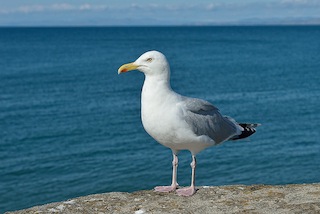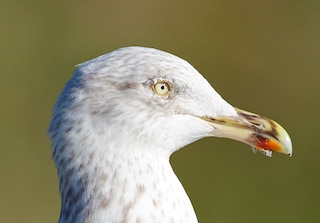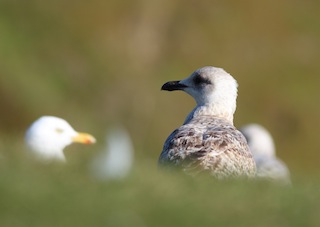 Did you know the Herring Gull is a red-listed species in the UK?
Did you know the Herring Gull is a red-listed species in the UK?
Photo: Amanda Scott
Scientific name: Larus argentatus
Other common names: European Herring Gull
Cornish name: Goolan loos
Conservation status: UK Birds of Conservation Concern, Red; IUCN Red List, Least Concern.
What to look for:
- Colouring and appearance: Grey back, white chest and underparts, black-tipped wings with white spots (known as mirrors), yellow bill with red patch and pink legs with webbed feet. Juveniles are mottled brown, transforming to adult plumage over the course of four years.
- Size: Length 60 cm, wingspan 144 cm.
- Where: Around the coast, and further inland. Globally it is distributed arund the northern hemisphere.
- Call: Familiar long call at seaside.
- Similar species: Common Gull (which is smaller).
 Herring Gulls don’t necessarily make the best of neighbours, especially if you’re eating an ice cream or sandwich at the seaside. With their bold outlook on life and opportunistic attitude to finding food, we are often wary of them as they fix us (or, rather, our food) with their yellow-rimmed eyes.
Herring Gulls don’t necessarily make the best of neighbours, especially if you’re eating an ice cream or sandwich at the seaside. With their bold outlook on life and opportunistic attitude to finding food, we are often wary of them as they fix us (or, rather, our food) with their yellow-rimmed eyes.
They have a wide distribution, so are very familiar by the coast or inland, where they flock round lakes and fields in the winter. The grey backs, white front, pink legs and yellow hooked bill with its red patch are all distinctive of adult Herring Gulls. Juveniles in their first winter are a mottled brown with a dark bill, gradually acquiring the adult plumage over the course of four winters (the top picture on this page is of an adult, the middle is a third winter gull, and the bottom picture is of a first winter juvenile).
 While they may like the odd ice cream cornet, Herring Gulls have a wide-ranging diet, including fish and offal, chicks, and discarded food on rubbish dumps. They can even cope with drinking saltwater by getting rid of the excess salt through glands close to their eyes. You’d think such an adaptable bird would be faring well in population terms, but in fact its numbers have declined over the last 25 years, and this bird now has a Red Status in the list of UK Birds of Conservation Concern.
While they may like the odd ice cream cornet, Herring Gulls have a wide-ranging diet, including fish and offal, chicks, and discarded food on rubbish dumps. They can even cope with drinking saltwater by getting rid of the excess salt through glands close to their eyes. You’d think such an adaptable bird would be faring well in population terms, but in fact its numbers have declined over the last 25 years, and this bird now has a Red Status in the list of UK Birds of Conservation Concern.
Did you know…?
…Poetic: the scientific name translates as ‘Seabird ornamented with silver’.
…Radio star: the call of the Herring Gull appears in the theme tune for Desert Island Discs.
…Hitting the right spot: the chicks tap the red spot on the adult’s beak, prompting their parent to regurgitate food for them.

More information and references:
Svensson, L., Mullarney, K., Zetterstrom, D.,1986. Collins Bird Guide, second edition (translated by Christie, D., Svensson, L.). HarperCollins, London.
Published: February 2015
Author: Amanda Scott
Photos: ©Natural England/Julian Dowse (upper); Amanda Scott (middle and lower)
